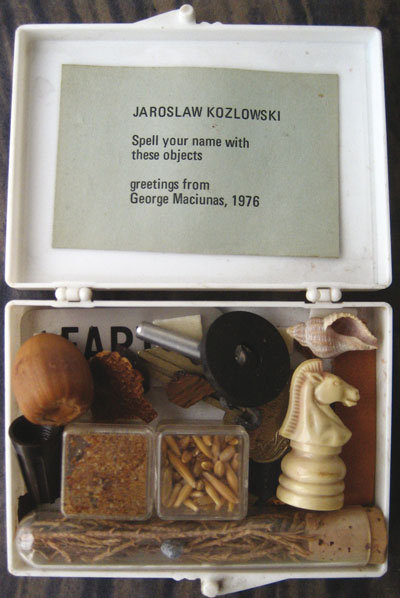Fluxus East
dal 16/4/2008 al 31/5/2008
Segnalato da
16/4/2008
Fluxus East
Ludwig Museum, Budapest
The exhibition shows parallel developments and artistic practices inspired by Fluxus, which are still adopted by some young artists today. Besides the classic Fluxus objects, the display will include photographs, films, correspondence, secret police files, interviews and recordings of music that document the presence of Fluxus in the former Eastern Bloc.

Fluxus is well-known as an (anti-)artistic, international network with centres in
the USA, Western Europe and Japan. But what about this “intermedia” art – art
encompassing music, actions, poetry, objects and events – beyond the “Iron Curtain”?
What echo did Fluxus find in the states of the former Eastern Bloc, and what
parallel developments existed there? As a “programme of action”, Fluxus – according
to its self-styled “chairman”, the exiled Lithuanian George Maciunas in a letter to
Nikita Chruscev – was predestined to bring about unity between the “concretist”
artists of the world and the “concretist” society of the USSR. Maciunas planned
Fluxus as a collective based on the model of the Russian LEF (Left Front of the
Arts). But these plans – e. g. for a performance tour by the artists on the
Trans-Siberian Railway –, developed with polished communist rhetoric in manifestos
and letters, were to remain no more than a utopia.
After 1962, a
different Fluxus East developed through creative exchange between Fluxus artists and
artists/musicians of the former Eastern Bloc, leading to events including concerts
with Fluxus compositions broadcast by Polish Radio (1964), Fluxus concerts in
Lithuania (1966), Prague (1966) and Budapest (1969), and later a Fluxus Festival in
Poznan (1977). Fluxus East represents a first stocktaking of the diverse Fluxus
activities in the former Eastern Bloc; the exhibition shows parallel developments
and artistic practices inspired by Fluxus, which are still adopted by some young
artists today. Besides the “classic” Fluxus objects, the display will include
photographs, films, correspondence, secret police files, interviews and recordings
of music that document the presence of Fluxus in the former Eastern Bloc. As an
interactive exhibition, Fluxus East aims to facilitate a profound encounter with
ideas, works and texts – some presented as facsimiles to permit intense study. It is
possible to play at Flux Ping Pong, and visitors are also invited to explore the
Poïpoïdrome by Robert Filliou.
Opening:
Thursday, 17 April 2008, 6.00 pm.
Opening speech by
Petra Stegmann, Curator
Guided tour and press reception:
17 April 2008, 5 pm.
Symposium
18 April 2008, 11.00 am – 8.00 pm
Hungarian-English translation service will be provided
Ludwig Museum
9th Komor Marcell 1 (Palace of Arts) - Budapest



